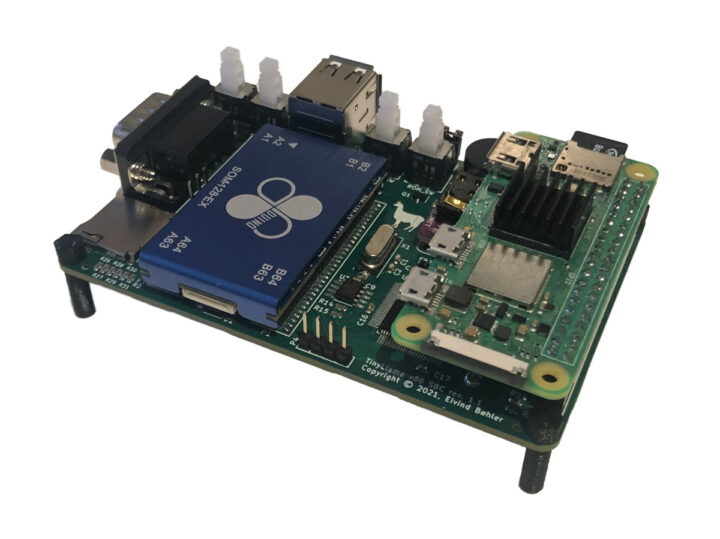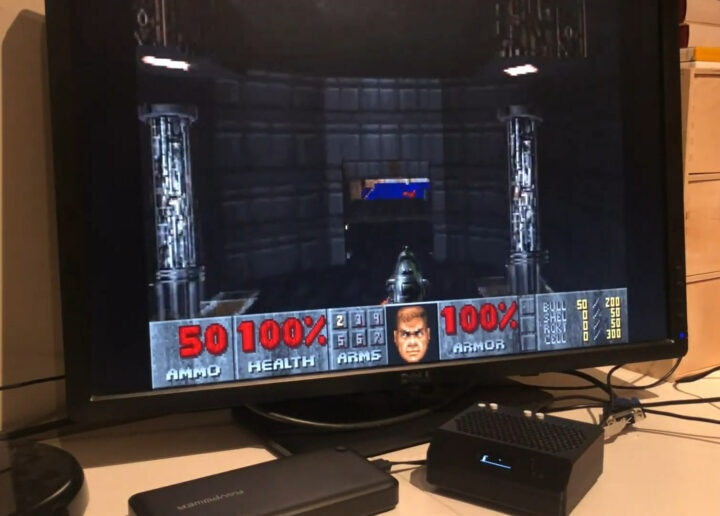The TinyLlama x86 retro computer board is designed to run DOS games on a DM&P Vortex86EX 32-bit x86 processor and integrates a MIDI synthesizer based on Raspberry Pi Zero 2 running MT32-Pi firmware.
Growing up playing games on 386/486-era computers, Eivind Bohler looked for similar recent hardware to play DOS games and after discovering the 86Duino x86 Arduino-compatible board, he decided to use the SOM-128-EX module powering the board to create the TinyLlama board with a Sound Blaster Pro-compatible Crystal CS4237B sound chip and a MIDI synthesizer.
TinyLlama specifications:
- D&MP SOM-128-EX system-on-module with
- Processor – DM&P Vortex86EX 32-bit x86 processor @ 60 to 500 MHz
- System Memory – 128MB DDR3
- Storage – 8MB SPI flash
- Storage – MicroSD card socket
- Video Output – VGA up to 1024×768 @ 60 Hz using the Vortex86VGA module running off an x1 PCI-e lane
- Audio
- Crystal CS4237B all-in-one audio chip
- MIDI synthesizer with Raspberry Pi Zero 2 W running MT32-Pi open-source firmware, GY-PCM5102 I²S DAC module, optional OLED display
- 12mm PC speaker
- 3.5mm line-out audio jack
- USB – 2x USB 2.0 Type-A connectors for keyboard, mouse, and/or storage
- Serial
- DE-9 RS232 serial port (COM1)
- 3-pin TTL serial connector (COM2)
- Misc
- CR1220 battery for RTC
- Power and reset buttons
- Button for toggling between MT32/General MIDI mode
- Button for switching between audio ROM’s / soundbanks
- 2-pin power connector for a fan (5V or 3.3V selectable)
- Power Supply – 5V via USB Micro-B port
- Power Consumption – ~4.5W with a Pi attached, ~3W without, depending on CPU frequency
- Dimensions – A bit larger than a Raspberry Pi model B board
The system features a custom Coreboot/SeaBIOS ROM, and is mostly designed to run MS-DOS or FreeDOS. There’s also a 3D-printed enclosure to make it look more like a mini PC or game console. The design is open-source hardware and you’ll find the KiCad schematics and PCB layout, source code for the BIOS and CS4237B firmware, files for the 3D printable enclosure, and documentation on GitHub. You can also follow the development and/or ask questions on Vogons forums.
If you don’t feel like building the TinyLlama by yourself, Eivind had 24 kits for sale last month, but I would suspect they are all gone by now…
Via Hackster.io

Jean-Luc started CNX Software in 2010 as a part-time endeavor, before quitting his job as a software engineering manager, and starting to write daily news, and reviews full time later in 2011.
Support CNX Software! Donate via cryptocurrencies, become a Patron on Patreon, or purchase goods on Amazon or Aliexpress







I think the using of Raspberry Pi’s in products is a good idea, but it makes them hard to get.
Only in the current supply/demand hellscape, which should be resolved within a year according to the Raspberry Pi Trading CEO Ebin Uptown in a recent interview.
The current supply situation is ridiculous. The Raspberry Pi Foundation is making half a million boards a month(!) but most are being gobbled up by companies. They could sell 5x that number. Quite clearly hobbyists and end users do not matter any more. It took me a YEAR to get 2x CM4 boards (8GB RAM/32GB eMMC) from CPC and I put both of these into WaveShare carriers with the same form factor as an RPi to emulate Pi 4B’s. I have given up on Pi Zeros and buy Banana Pi clones (even though they are nowhere near as good) instead. Why doesn’t somebody make a low end laptop (like a netbook) based on the top specification CM4 for children (128GB eMMC would be better Raspberry Pi Foundation). I use a Pi 400 as a desktop computer (for test purposes) with an external USB connected SSD – annoyingly with a German keyboatd!). You could easily build an M2 slot into it and make it into a serious little desktop computer. It’s perfect for education in the UK.
Using a Pi Zero 2 as MIDI synthesizer? Shouldn’t a Pi Pico be able to do that?
Apparently it requires some processing power. If you check the repo for the MT32-Pi project:
Wow, never though that emulating a MIDI synthesizer would be heavy like this
You can just go to dosgamesarchive and play games online or dosgames for a download site, in case anyone wants to try without buying hardware.